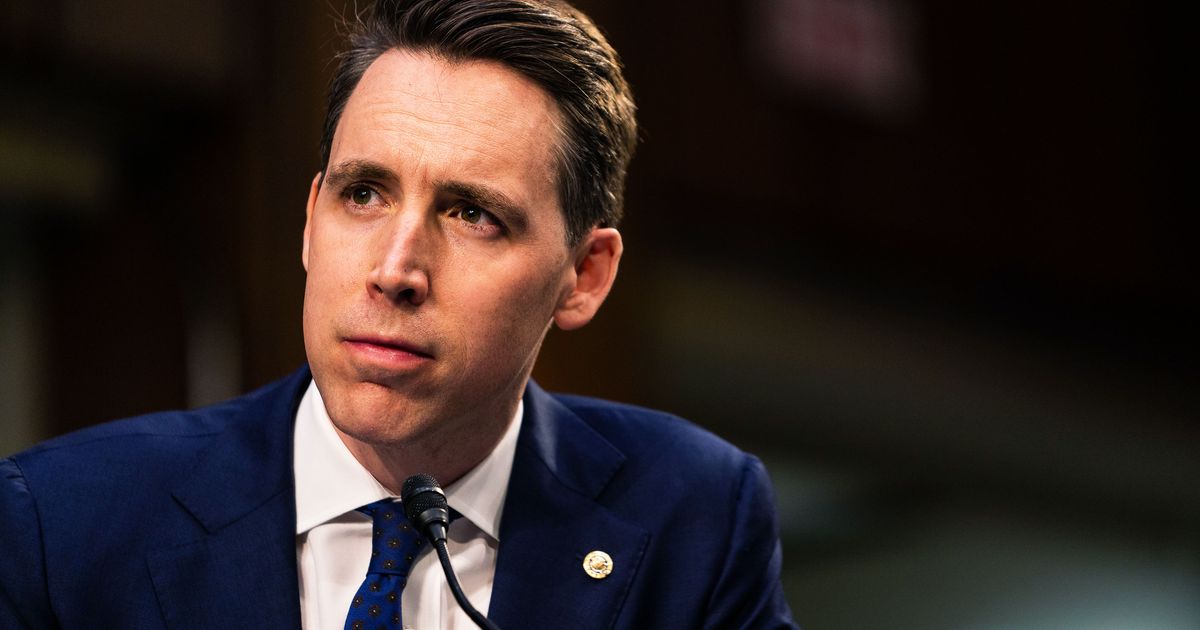
- Select a language for the TTS:
- UK English Female
- UK English Male
- US English Female
- US English Male
- Australian Female
- Australian Male
- Language selected: (auto detect) - EN
Play all audios:
Self-styled populist, and borderline protofascist, Josh Hawley. Photo: Demetrius Freeman/The Washington Post/Bloomberg via Getty Images One of the perennial challenges of conservative
politics in democratic countries is that conservative policies aren’t, generally speaking, very popular. That may be inevitable for those whose worldviews embrace militant capitalism, a
limited role for government in redressing wrongs, the moral unfitness of the undeserving poor, and a natural order of things that consigns large majorities to a subordinate positions in
society and the economy. Some conservatives, moreover, are soldiers of authoritarian religious and/or cultural movements that are not terribly compatible with the ebb and flow of the
political marketplace at any given moment. A lot of right-wing parties around the world have accepted much of the modern welfare state. But here in the U.S., conservatives have grudgingly
accepted the popularity of liberal policies. By way of compensation for their built-in disadvantages, U.S. conservatives over the years have become adept at posing as champions of the _real
_salt-of-the-earth Americans, in a fight against liberal elites who despise both the values and the material interests of regular folks. This “conservative populism” should not be confused
with the nearly extinct tradition of liberal Republicanism, common in some parts of the country before the post-civil-rights ideological sorting out of the two parties. Liberal Republicans
typically competed with Democrats for the allegiance of many of the same voters, deploying many of the same messages and policies. Right-wing “populists” haven’t so much competed with
Democrats as they have denied their legitimacy as representatives of the “silent majority” (a term devised by pioneer conservative populist Richard Nixon and revived by Donald Trump). But at
this point in the 21st century, conservative populism and the Republican Party are both at a negative inflection point, having lost power in Washington and now facing hostile demographic
trends. What are their options for getting on the right side of public opinion without exposing themselves to the RINOism charge hurled at anyone inching toward the old-school liberal
Republican accommodation of enemy doctrine? Here are some possibilities: While conservatives inherently resist use of government power to advance broad-based prosperity via redistribution of
resources, Republicans have battened for decades on what might be described as _re-redistribution_: showering tax or programmatic benefits on those allegedly plundered by liberal tax and
spending policies. Every major GOP exercise in flattening marginal tax rates for the very wealthy has been marketed as broad-based tax relief for middle-class families. Similarly, regulatory
relief for major corporations has been invariably described by proponents as relief for workers in such affected industries as mining and manufacturing. In recent years re-redistribution of
resources to promote conservative cultural values has also come into vogue: Subsidies for families was fundamental to such “reformicons” as Reihan Salam and Ross Douthat more than a decade
ago, and is now being promoted by Trump ally and _American Greatness_ publisher Christopher Buskirk in a New York _Times_ column: > Republicans have long prided themselves on being the
pro-family > party. But what does that really mean? The debate over the [Biden] > child allowance makes that palpable. And it’s forcing Republicans > to decide who they are. Will
they be the party of capital gains tax > cuts or of cash payments that make it more practical for parents to > raise their own children? This is an example, in fact, of how Republicans
can sometimes support the same policies backed by Democrats for very different reasons. Buskirk wants, in essence, an enhanced minimum family income so that mothers can stay at home and
raise children. Motives aside, this posture aligns Republicans more securely with public opinion, while obscuring the fact that they do so to advance stridently reactionary goals that remain
in the background. The quickest way to distance conservatives from economic elitism is to selectively attack corporate elites, preferably those assumed to promote liberal cultural values or
political aims. Self-described conservative populist Josh Hawley is a master of this approach, launching thunderbolts at Silicon Valley and Big Tech for anti-competitive practices that
happen to be associated with cultural liberalism and even “wokeness,” alongside alleged suppression of conservative points of view. This gambit became more transparent when Donald Trump
adopted it vocally in 2020 after social-media platforms began censoring and then banning his lies. Hawley and other conservative populists emulate an age-old right-wing tradition that offers
highly selective solidarity with the corporate enemies of traditional working-class folk: producerism. The idea is to champion employers and employees alike in “productive” industries that
extract raw materials from the Earth and then make things from them, in sharp contrast to the “parasites” that do nothing productive at all, ranging from financial speculators to academics
to mass media to those who are dependent on government as employer or benefactor. Producerism is catnip for conservative populists, because it denies the economic class conflict central to
leftist political thinking and realigns people vertically based on what they do rather than what they earn. It’s a handy way to demonize finance capitalists, “woke” university professors,
hedge-fund managers, Big Tech, labor unions, and the “underclass” as one big ball of hellish and destructive opposition to Real Americans. There are problems with full-on producerism, of
course. One is that there are few groups of Americans more fundamentally productive than the immigrants who conservative populists also tend to demonize. Another is the unsavory association
of producerism with every fascist movement in modern history, and with the anti-Semitism such movements have so often embraced. It’s not easy, even in the 21st century, to find oneself
nodding along with the insights of Mussolini, Franco, and Hitler. It’s become a truism of the Trump era that Republicans have sought to energize their base via the rawest and most divisive
types of culture-war themes. Trump’s undoubted commitment to the anti-abortion cause, for example, and his support for religious immunity from anti-discrimination laws, for another,
solidified his support among white conservative Evangelicals in both 2016 and 2020. But as intense as support for banning abortion and neutering LGBTQ rights are among the “base,” these are
not popular causes generally, much less among the rising generations of present and future voters. So one way to make conservative populism more popular is to find cultural issues that unite
a majority of Americans and the conservative “base.” On the reproductive-rights front, this is an old story: Conservatives who want to ban all abortions from the moment of conception focus
incessantly on the small and medically dictated number of late-term abortions. Similarly, Republicans are incessantly targeting transgender rights and the alleged threat to previously
little-known imperatives like the integrity of women’s sports records. And above all, conservative attacks on “wokeness” and “cancel culture” promote a usefully general defense of
intolerance as insufficiently tolerated by the “elites” who don’t appreciate the political incorrectness of real Americans. All sorts of sexist, homophobic, and racist nastiness can find
popular sanction from cleverly framed culture-war messages. The simplest way to turn popular minorities into majorities, of course, is to make the former into the latter by excluding hostile
elements of the population from voting or effective representation. There’s an ancient conservative tradition of dealing with the threat of popular democracy via constitutional limits on
what government can do, anti-majoritarian schemes for representation, and then restrictions on the franchise. Today’s conservatives deploy all three weapons. For conservative “populists,”
however, the rather obvious anti-populism of restrictions on voting has required a heavy, heavy deployment of ludicrous conspiracy theories, which in turn implicitly rely on producerist
ideas about elite–underclass cooperation to rig elections and deny the popular will. Indeed, this has been one undeniably powerful legacy Donald Trump has bequeathed to conservative
populists, investing them deeply in efforts to redefine “popular” to mean the opinions of their own segment of the population. All these avenues are open to those battling to reverse the
outcomes of the 2020 election and to forestall the arrival of voting cohorts inhospitable to conservatism. Many Republican pols, of course, don’t really care how they hang onto or recover
power; just battling Biden, attacking “socialism,” and counting on historically probable midterm gains in 2022 is enough. But eventually, the Republican Party will need to define itself, and
even if Trump continues to be its leader, just howling and growling may not perpetually be enough. Thank you for subscribing and supporting our journalism. If you prefer to read in print,
you can also find this article in the , issue of New York Magazine. Want more stories like this one? Subscribe now to support our journalism and get unlimited access to our coverage. If you
prefer to read in print, you can also find this article in the , issue of New York Magazine.







